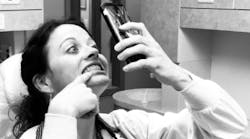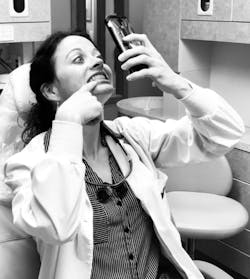Unsupervised dentistry: Dentist buddy-buddies, fixing 'gum decay,' and DIY ortho aligners—say what?!
Dr. Stacey Simmons goes undercover, pretending to be a potential customer for a DIY orthodontics company. She shares snippets of her conversation (everything you need to know about "gum decay" and buddies!), as well as her take on unsupervised dentistry and what transpires when you strike out on your own to get orthodontics aligners and circumvent the dentist.
Editor's note: This article first appeared in Breakthrough Clinical, the clinical specialties newsletter created just for dentists. Browse our newsletter archives to find out more and subscribe here.
One would assume that when you’re working a customer support line, being knowledgeable about the product and services you are trying to sell would be a prerequisite. However, in a twisted way of playing devil’s advocate, most people who call into these hotlines are not dental savvy. They don’t really know what to ask, and, as a result, red flags to us mean nothing to them. See where I’m going with this?
Here are a few examples of what I encountered.
From my phone call:
• ME: "I haven’t seen a dentist in a while, and I’m pretty sure I have cavities. Do I have to see a dentist and get these fixed before I get my aligners?"
• CUSTOMER SUPPORT: "Well, we recommend that you see a dentist, but it’s not required that you get the cavities taken care of, and besides, it’s not like you have to be buddy-buddy with your dentist either. I would just go find a dentist and get a checkup, and if you want to get any work done, then that is up to you. It can affect your teeth and fit of the aligners if you don’t get them fixed though."
• ME: "I noticed you said a word I’ve never heard before—periodontal. What is that?"
• CUSTOMER SUPPORT: "You know, gum decay—it’s where your teeth rot out and cause your gums to decay because of all the rot. Bottom line—brush your teeth—it's soooo simple!" (She said this as if I should already know what "gum decay" was. Really? Bite your tongue, Stacey...bite your tongue.)
From their YouTube video:
• A customer was concerned about a "black triangle" that appeared between his maxillary front teeth after a few months of wearing the aligners. Apparently, to fix this, all you have to do is go to Amazon and purchase small, thin strips of "sanded wire" to file your teeth down so they move more and voila! The triangle is gone! Yup. Just. Like. That. Well, guess what? The customer filed his teeth down, but the aligners didn’t accommodate for the movement needed to bring the teeth together due to the additional 2 mm of space that was created.
• CUSTOMER: "I wish I had known that my bite would change once I started these aligners. Before, my teeth were like this (demonstrates a generalized Class I bite). Now, they’re like this." (He bites down, puts his face up to the camera, and shows a cross-bite. Yup, that’s what happens when you moveteeth. Things change!)
You can’t make this stuff up. Gum decay? Buddy-buddy? Don’t worry about getting the cavities fixed? Really?!? You may think I’m joking or adding in a bit of drama for the sake of a good blog, but this is exactly what is going on in our instant-gratification, you-can-do-anything-yourself world. If you Google "DIY ORTHO," you generate more than two million results, and while DIY may be great for cooking, changing a leaky faucet, or a flat tire, it should not be the go-to for orthodontics. The potential for unsupervised damage can be irreversible and cost thousands more to fix, not to mention the extremely high litigious potential for those seeking restitution because they "didn’t get the smile they deserved or were promised."
It would, therefore, be prudent to ask what the driving force is behind this "Overton window" (sans politics) type of shift in what is normal, believable, and, subsequently, acceptable for all things DIY. We’ve seen this in dentistry before with bleaching, and now it's ortho's turn. Think about it—with a selfie, an impression kit sent directly to you, and a credit card, you can really "have the smile you deserve—it’s quick, simple, and costs half of what traditional braces do!"
So, while consumers are hearing what they want to hear—because as we all know, everything you read on social media is gospel—all of us in the dental industry are shaking our heads thinking about all the what-ifs and potential issues that arise from unsupervised movement of biological materials. Many have had positive results from their treatment, but there will still be plenty of messes that we get to clean up. I’ll submit that this is just the tip of the iceberg, because this service is still in its infant stages and picking up steam fast.
The awareness of this topic has been expressed by several organizations, including the American Association of Orthodontists. In fact, they have provided a Consumer Alert on their website for those who may be considering this type of care. You can find it at this link. (1)
While generating discussions and educating people around us about the differences between unsupervised ortho versus care with a professional is essential, I’ll acquiesce to the likely fact that our voice is going to be drowned out in the overload of social media and opinions of consumers who have "been there and done that." For some reason, those testimonies are more believable than the prudent advice and concerns we give as professionals. In a sense, our presence is important only when something goes wrong. Yeah, I know, it’s backwards.
I don’t have all of the answers to this conundrum, but what I do know is that there is no such thing as "gum decay" and that being buddy-buddy with your dentist/orthodontist is an excellent idea—especially if you really want a healthy smile that is done the right way.
— Dr. Stacey
Stacey L. Simmons, DDS
Editorial Director, Breakthrough Clinical
Reference
1. Consumer Alert from the AAO. Questions to Consider When Researching Direct-To-Consumer Orthodontic Companies. American Association of Orthodontists website. https://www.aaoinfo.org/1/online-orthodontic-companies. Accessed February 6, 2019.
LAST MONTH >> She's baaaack...and her dentist in California is still smarter and better
Editor's note: This article first appeared in Breakthrough Clinical, the clinical specialties newsletter created just for dentists. Browse our newsletter archives to find out more and subscribe here.
Keep reading more articles about clinical dentistry at this link.
For the most current dental headlines, follow this link.
About the Author
Stacey L. Simmons, DDS
Editorial Director of DE's Breakthrough Clinical e-newsletter
Dr. Stacey Simmons grew up in Hamilton, Montana. She did part of her undergraduate work at Purdue University and then received her bachelor’s degree in exercise physiology from the University of Utah. After applying to both medical and dental school, she decided that dentistry was her career of choice. She received her DDS degree from Marquette University School of Dentistry in Milwaukee, Wisconsin, in 2004. In private practice, she focuses her care on prosthodontics and cosmetic dentistry. She is a guest lecturer in the Anatomy and Physiology Department at the University of Montana. Outside the office, she trains for triathlons and spends time with her family. You may contact Dr. Simmons by email at [email protected].
In 2015, Dr. Simmons became the editorial director of DE's Breakthrough Clinical with Stacey Simmons, DDS, an e-newsletter focused on breaking through plateaus in clinical practice. Subscription information may be found here.
Updated May 4, 2016


